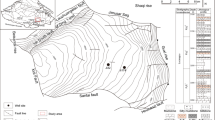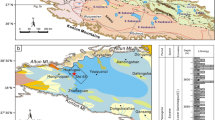Abstract
Source rock potential of the shallow-water evaporite-carbonate sequences at Salt Flat sabkha (playa) was evaluated on the basis of total organic carbon TOC), extractable organic matter and Rock Eval pyrolysis.
Sedimentological evidence indicates periodic anoxicity in the Salt Flat brine lake during evaporite deposition. This was caused during wetter intervals when inflowing runoff rested on denser brine, forming a halocline. Brine stratification inhibited free circulation of oxygen in the lake bottom, enhancing the preservation of organic matter.
Organic matter in gypsum-rich horizons is dominantly of algal origin. Average organic carbon content of the sediments is 0.6% but may be 1.2% or more in gypsum-rich sediments. Hydrogen Index is generally high, ranging from a low of 300 mg HC g/Corg for gypsum-rich beds.
Similar content being viewed by others
References
BELLANCA, A., and NERRI, R., 1986, Evaporite carbonate cycles of the Messinian, Sicily: stable isotopes, mineralogy, textural features, and environmental implications: Journal of Sedimentary Petrology, Vol. 56, p. 614–621.
BOROWITZKA, L.J., 1981, The microflora: adaptations to life in extremely saline lakes: Hydrobiologia, Vol. 81, p. 33–46.
CLARK, R.C., Jr., and BLUMER, M., 1969, Distribution of n-paraffins in marine organisms and sediment: Limnology and Oceanography, Vol. 12, p. 79–87.
EUGSTER, H.P., and HARDIE, L.A., 1975, Sedimentation in an ancient playa-lake complex: the Wilkins Peak member of the Green River formation of Wyoming: Bulletin Geological Society of America, Vol. 86, p. 319–334.
EVANS, R., and KIRKLAND, D.W. 1988, Evaporite environments as a source of petroleum:in B.C. Schreiber (ed.) Evaporites and Hydrocarbons: Columbia University Press, p. 256–299.
FRIEDMAN, G.M., 1966, Occurrence and origin of Quaternary dolomite of Salt, Flat, west Texas: Journal of Sedimentary Petrology, Vol. 36, p. 263–267.
GEHMAN, H.M., Jr., 1962, Organic matter in limestone: Geochimica et Cosmochimica Acta, Vol. 26, p. 886–896.
HAMMER, U.T., 1981, Primary production in saline lakes: a review: Hydrobiologia, Vol. 81, p. 47–57.
HEDBERG, H.D., 1967, Geologic control of petroleum genesis: Proceedings 7th World Petroleum Congress, v. 2, p. 3–11.
HUSSAIN, M., 1988, n-alkane in continental evaporitecarbonate sequences and its possible implications in paleoclimate study: a study in Salt Flat sabkha, west Texas-New Mexico: Bulletin of the Geological Society of America, Ahstracts with Program, Vol. 20, p. 347.
HUSSAIN, M., and WARREN, J.K., 1988, Dolomitization in sulfate-rich environment: a modern example from Salt Flat sabkha (dried playa lake) in west Texas-New Mexico: Carbonates and Evaporites, Vol. 3, p. 473–480.
HUSSAIN, M., and WARREN, J.K., 1989, Nodular and enterolithic gypsum: the “Sabkha-tization” of Salt Flat playa, west Texas: Sedimentary Geology, Vol. 63, p. 13–24.
JONES, R.W., 1984, Comparison of carbonate and shale source rocks:in Palacas, J.G. (ed.) Petroleum Geochemistry and Carbonate Source Rocks: American Association of Petroleum Geologists, Studies in Geology 18, p. 51–68.
KIRKLAND, D.W., and EVANS, R., 1981, Source-rock potential of evaporitic environment: American Association of Petroleum Geologists Bulletin, v. 65, p. 181–190.
KUZNETSOVA, V.A., and PANTSKHAVA, E.S., 1962, Effect of freshening of stratal water on development of halophilic sulfate reducing bacteria: Mikrobiologia. Vol. 31, p. 129.
MALEK-ASLANI, M., 1980, Environmental and diagenetic controls of carbonate sediments from the coastal sabkhas of Abu Dhabi, U.A.E: Gulf Coast Association of Geological Societies Transactions, Vol. 30, p. 445–458.
MCKIRDY, D.M., and KANTSLER, A.J., 1980, Oil geochemistry and potential source rocks of the Officer Basin, South Australia: Australian Petroleum Exploration Association Journal, Vol. 20, p. 68–86.
MCKIRDY, D.M., KANTSLER, A.J., EMMETT, J.K., and ALDRIDGE, A.K., 1984, Hydrocarbon genesis and organic facies in Cambrian carbonates of the eastern Officer Basin, South Australia:in Palacas, J.G., (ed.) Petroleum Geochemistry and Source Rock Potential of Carbonate Rocks: American Association of Petroleum Geologists, Studies in Geology 18, p. 13–30.
MITTERER, R.M., DZOU, I.P., MIRANDA, R.M., and CAUGHEY, M.E., 1988, Extractable and pyrolyzed hydrocarbons in shallow-water carbonate sediments, Florida Bay, Florida: Organic Geochemistry, Vol. 13, p. 283–294.
PALACAS, J.G., ANDERS, D.E., and KING, J.D., 1984, South Florida Basin, A prime example of carbonate source rocks of petroleum:in Palacas, J.G. (ed.) Petroleum Geochemistry and Source Rock Potential of Carbonate Rocks: American Association of Petroleum Geologists, Studies in Geology 18, p. 71–96.
PETERSON, J.A., and HITE, R.J., 1969, Pennsylvanian carbonate-evaporite cycles and their relation to petroleum occurrence, southern Rockey Mountains: American Association of Petroleum Geologists Bulletin, v. 53, p. 884–908.
PIERRE, C., and CATLANO, R., 1976, Stable isotopes (180, 13C, 2H) in evaporite sequences of the Aiminna Basin (Sicily):in Catlano, R., Ruggieri, G., and Sprovieri, R., (eds.), Messinian Evaporites in the Mediterranean.
POWELL, T.G., 1978, An assessment of the hydrocarbon source rock potential of the Canadian Arctic Islands: Geological Survey of Canada Paper 78-12, p. 82
POWELL, T.G., 1984, Some aspects of the hydrocarbon geochemistry of a Middle Devonian barrier-reef complex, western Canada:in Palacas, J.A., (ed.) Petroleum Geochemistry and Source Rock Potential of Carbonate Rocks, American Association of Petroleum Geologists, Studies in Geology 18, p. 45–61.
TISSOT, B.P., and WELTE, D.H., 1984, Petroleum Formation and Occurrence: Springer-Verlag, New York, p. 538.
TRUPER, H.G., 1969, Bacterial sulfate reduction in the Red Sea hot brines:in Degens. E.T., and Ross, D.A., (eds.) Recent Heavy metal Deposits in the Red Sea: A Geochemical and Geophysical Account, Springer-Verlag, New York.
WARREN, J.K, 1986, Shallow-water evaporite environments and their source rock potential: Journal of Sedimentary Petrology, Vol. 56, p. 442–454.
WARREN, J.K., 1989, Evaporite Sedimentology: Importance in Hydrocarbon Accumulation: Prentice-Hall Advanced Series, Inglewood Cliffs; NJ, 285 p.
WOOLNOUGH, W.G., 1937, Sedimentation in barred basins, and source rocks of oil: American Association of Petroleum Geologists Bulletin v. 21, p. 1101–1157.
ZHANG YI-GANG, 1981, Cool shallow origin of petroleum-microbial genesis and subsquent degradation: Journal of Petroleum Geology, Vol. 3, p. 427–444.
Zumberge, J.E., 1984, Source rocks of the La Luna Formation (Upper Cretaceous) in the middle Magdalena Valley, Colombia:in Palacas, J.G. (ed.) Petroleum Geochemistry and Source Rock Potential of Carbonate Rocks: American Association of Petroleum Geologists, Studies in Geology 18, p. 127–133.
Author information
Authors and Affiliations
Rights and permissions
About this article
Cite this article
Hussain, M., Warren, J.K. Source rock potential of shallow-water evaporites: An investigation in holocenepleistocene Salt Flat sabkah (playa), west Texas-New Mexico. Carbonates Evaporites 6, 217–224 (1991). https://doi.org/10.1007/BF03174424
Received:
Accepted:
Published:
Issue Date:
DOI: https://doi.org/10.1007/BF03174424




